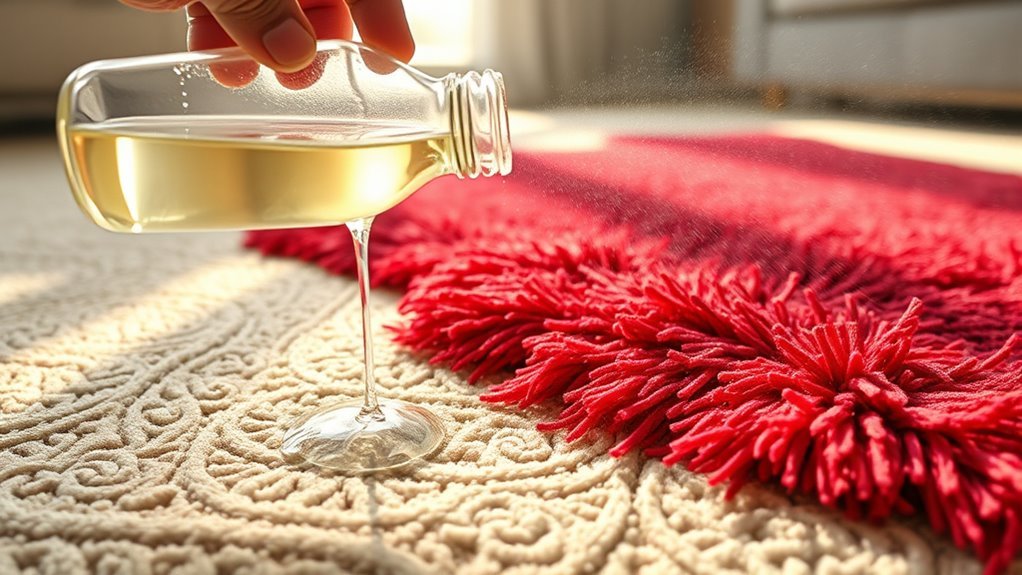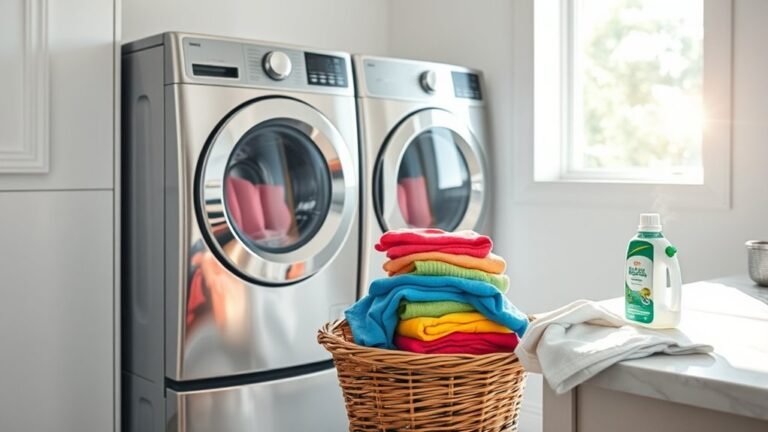DIY Cleaner for Carpet
You can make a simple DIY carpet cleaner by mixing half a cup of white vinegar, one cup of warm water, and a teaspoon of liquid castile soap in a spray bottle. Sprinkle baking soda on your carpet to absorb odors before vacuuming. For stains, combine vinegar, dish soap, and water to gently lift spots without harsh chemicals. This natural approach keeps your carpet fresh and safe. If you want tips on spot cleaning and caring for different carpets, keep exploring these ideas.
Essential Ingredients for Homemade Carpet Cleaner

Before you start mixing your own carpet cleaner, it’s important to know which ingredients work best for removing stains and odors without damaging your carpet fibers. When exploring homemade recipes, focus on eco friendly options like white vinegar, baking soda, and liquid castile soap. White vinegar naturally breaks down stains and neutralizes odors, while baking soda absorbs moisture and freshens carpets. Castile soap gently lifts dirt without harsh chemicals. These simple, non-toxic ingredients give you the freedom to clean safely and sustainably, avoiding commercial cleaners filled with synthetic substances. You can customize your blend depending on your carpet’s needs, maintaining control over what touches your home. Choosing these essential ingredients means you’re embracing a cleaner, greener lifestyle without sacrificing effectiveness or your liberty to choose.
How to Prepare a Basic Carpet Cleaning Solution
To prepare a basic carpet cleaning solution, you’ll only need three simple ingredients: white vinegar, baking soda, and liquid castile soap. Start by mixing one cup of warm water with half a cup of white vinegar. Add one teaspoon of liquid castile soap and stir gently. This blend works wonders on carpet fibers, lifting dirt without harsh chemicals. Keep this solution in a spray bottle for easy use. Remember, adjusting your cleaning frequency based on foot traffic helps maintain your carpet’s look and feel. For regular upkeep, once a week or biweekly application is enough to keep carpet fibers fresh and clean. With this DIY formula, you’re free to maintain your carpets naturally, avoiding store-bought cleaners’ toxins while saving money.
Using Baking Soda to Remove Odors

When your carpet starts to hold onto unpleasant smells, baking soda can be a simple and effective solution. One of the baking soda benefits is its natural odor absorption, which helps neutralize and eliminate stubborn scents without harsh chemicals. To use it, just sprinkle a generous layer over your carpet, focusing on the areas that smell the worst. Let it sit for at least 15 minutes—longer if you can, even overnight for deep odor absorption. Afterward, vacuum thoroughly to remove the powder along with trapped odors. This method frees you from relying on commercial sprays and keeps your space fresh naturally. Baking soda’s versatility makes it a go-to choice for maintaining a clean, odor-free carpet with minimal effort.
Tackling Stains With Vinegar and Dish Soap
Although stains on your carpet can be frustrating, you don’t have to reach for harsh chemicals to get rid of them. A simple mix of vinegar and dish soap offers a powerful, natural solution. Vinegar benefits include breaking down tough stains and neutralizing odors, while dish soap cuts through grease and lifts dirt. To tackle stains, combine one cup of white vinegar with one tablespoon of dish soap and two cups of warm water. Apply the mixture to the stain, let it sit for 5-10 minutes, then gently blot with a clean cloth. This DIY cleaner gives you the freedom to maintain a fresh, stain-free carpet without relying on commercial products packed with unnecessary chemicals.
Applying the Cleaner to Different Types of Carpets

Since every carpet type reacts differently to cleaning solutions, you’ll want to test the vinegar and dish soap mixture on a small, hidden area first. When applying cleaner to synthetic carpets, use a gentle spray and blot to avoid over-wetting. For applying cleaner to wool carpets, apply sparingly and blot gently to protect the fibers. Here’s how you can approach different carpets:
- Synthetic carpets: Spray lightly, blot immediately
- Wool carpets: Use minimal cleaner, blot gently
- Berber carpets: Avoid scrubbing, blot with a cloth
- Nylon carpets: Can tolerate a bit more moisture but blot well
- Olefin carpets: Test thoroughly, avoid soaking
This tailored approach gives you freedom to clean effectively without risking damage.
Tips for Spot Cleaning With DIY Solutions
When tackling spots on your carpet, knowing which DIY solution works best for common stains can save you time and effort. You’ll also want to use the right application techniques to avoid spreading the stain or damaging the fibers. Let’s explore some simple remedies and how to apply them effectively.
Common Stain Remedies
If you want to tackle carpet stains effectively, using DIY solutions can be both affordable and efficient. When dealing with common messes like pet accidents or red wine spills, a quick response and the right remedy make all the difference. Here are some go-to DIY stain removers you can try:
- Pet accidents: Blot the area, then apply a mix of white vinegar and water to neutralize odors.
- Red wine: Sprinkle salt immediately, then dab with a baking soda paste.
- Coffee: Use a solution of dish soap and warm water to lift the stain.
- Grease: Apply cornstarch to absorb oil, then vacuum before spot cleaning.
- Ink: Dab with rubbing alcohol on a cloth to break down the stain.
These simple remedies help you reclaim your carpet freedom without breaking the bank.
Application Techniques
Knowing which DIY solutions work best for various stains is just part of the process. Mastering effective application methods and choosing the right cleaning tools are key to freeing your carpet from spots. Start by blotting the stain gently with a clean cloth—never rub, as it spreads the mess. Use a spray bottle for even distribution of your DIY cleaner, then let it sit briefly. Finally, blot again to lift the stain.
| Stain Type | Application Method | Recommended Tool |
|---|---|---|
| Coffee | Spray and blot | Microfiber cloth |
| Pet Urine | Dab with solution, then blot | Soft-bristle brush |
| Wine | Apply cleaner, wait 5 mins | White cotton cloth |
| Grease | Sprinkle baking soda first | Vacuum + cloth |
These steps help you reclaim your carpet with confidence.
Natural Alternatives for Carpet Freshening
Although commercial carpet fresheners can be effective, you might prefer natural alternatives that are safer for your home and the environment. Embracing eco friendly options not only protects your living space but also gives you control over the ingredients you use. Homemade fresheners are simple to make and just as effective at freshening your carpets.
Try these natural carpet freshening ideas:
- Baking soda mixed with a few drops of essential oils
- Dry cornstarch combined with ground cloves or cinnamon
- Activated charcoal placed in breathable sachets nearby
- White vinegar diluted with water for light misting
- Fresh herbs like rosemary or lavender tucked into fabric bags
These choices let you maintain a fresh home without compromising your values or freedom.
Safety Precautions When Using Homemade Cleaners
When using homemade cleaners, you should always take a few key safety precautions to protect yourself and your home. First, wear appropriate safety gear like gloves and goggles to shield your skin and eyes from any irritation. Even natural ingredients can trigger chemical sensitivity, so it’s important to test your cleaner on a small carpet area before full use. Make sure you’re working in a well-ventilated space to avoid inhaling fumes, especially if you mix ingredients like vinegar or essential oils. Store your DIY cleaner safely, away from children and pets, and clearly label the container. By taking these simple steps, you maintain your freedom to clean naturally while keeping your living space and yourself safe from unintended harm.
Frequently Asked Questions
How Often Should I Deep Clean My Carpet With DIY Solutions?
You should aim to deep clean your carpet every 6 to 12 months, depending on your cleaning frequency and lifestyle. If you have pets or kids, more frequent cleaning might be needed. For easy maintenance, vacuum regularly and spot-clean spills immediately. These tips help keep your carpet fresh and extend its life, giving you the freedom to enjoy a cleaner space without spending hours on tough messes.
Can DIY Carpet Cleaners Damage Carpet Fibers Over Time?
Think of your carpet like a vintage leather jacket—you want to preserve its charm without wearing it down. Using harsh DIY cleaners too often can harm carpet fibers, cutting short its longevity. But if you choose gentle, fiber-protecting ingredients and avoid over-saturating, you’re giving your carpet the freedom to stay fresh and strong. Balance is key; treat it well, and your carpet will reward you with lasting beauty.
What’S the Best Way to Dry Carpets After Using Homemade Cleaner?
After cleaning your carpet, the best way to dry it is by using effective carpet drying techniques like opening windows, turning on fans, and using dehumidifiers. These methods speed up airflow and reduce moisture. Keep in mind, drying time factors include room temperature, humidity, and carpet thickness. You’ll want to avoid walking on it until it’s completely dry to prevent dirt and damage, giving your carpet the freedom to dry thoroughly and stay fresh.
How Do I Remove Pet Hair Before Applying the Cleaner?
Before applying any cleaner, you’ll want to tackle pet hair effectively. Start with regular pet grooming to reduce shedding at the source—brushing your furry friend often helps a lot. Then, use strong vacuum techniques: vacuum slowly and in multiple directions to lift hair trapped deep in fibers. This way, you’ll free your carpet from loose hair, making your cleaning process smoother and your space feeling fresh and unrestricted.
Are DIY Cleaners Effective on Synthetic vs. Natural Carpets?
You’ll find DIY cleaners generally work well on both synthetic fibers and natural fibers, but their effectiveness can vary. Synthetic fibers tend to resist stains better, so homemade solutions often do a great job without harsh chemicals. Natural fibers are more delicate, so you’ll want to use gentler ingredients to avoid damage. Trust your instincts, test small spots, and adjust your mix to keep your freedom in fresh, clean carpets.






